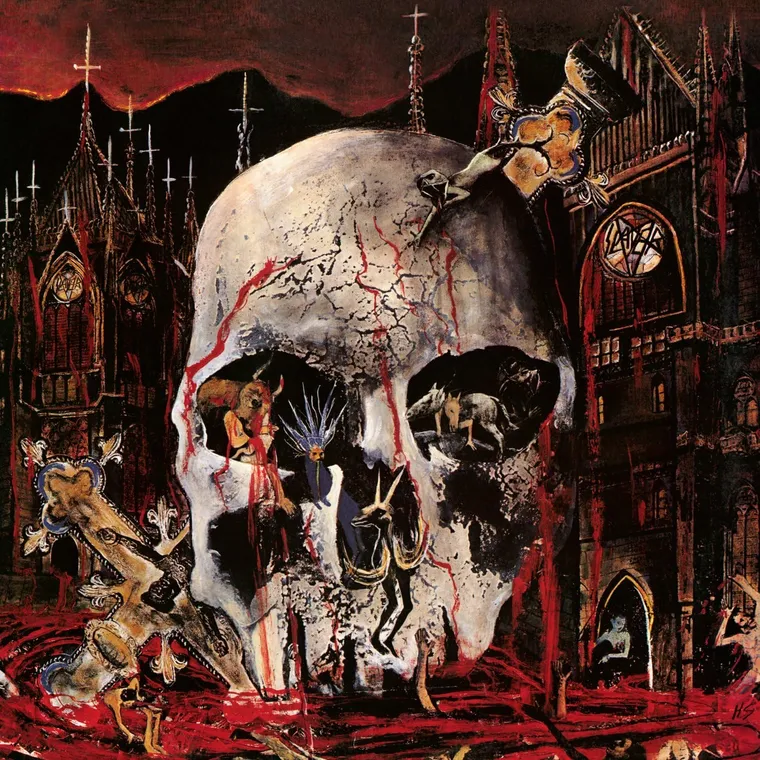Released on July 5, 1988, South of Heaven, Slayer's fourth studio album, was released on July 5, 1988, and is still regarded as one of the most audacious and atmospherically ominous albums in thrash metal history. Slower tempos, darker moods, and a nagging sense of evil that lingers long after the last note fades were characteristics of South of Heaven, which marked a change from earlier albums like Reign in Blood that broke down boundaries with sheer speed and brutality. Reign in Blood tore through boundaries with sheer speed and brutality; South of Heaven marked a shift: slower tempos, darker moods, and a creeping sense of evil that lingers long after the last note fades.
Where their previous work relied on blitzkrieg pacing and unrelenting aggression, South of Heaven refines that chaos into something colder and more calculated. It’s the sound of a band evolving—not softening, but maturing, choosing restraint over repetition, and channeling their rage into something even more unsettling.
Crafted under the razor-sharp production of Rick Rubin and the band themselves, South of Heaven showcases Slayer tightening their vision without losing their menace. The result is an album that’s both brooding and blistering, filled with apocalyptic imagery, wickedly intricate riffs, and an oppressive atmosphere that feels biblical in its wrath.
South of Heaven: The Descent Begins
The album opens with the title track, “South of Heaven,” a slow-burning dirge that immediately signals a change in direction. Gone is the warp-speed thrashing of Reign in Blood; in its place is a haunting, deliberate march into darkness. Tom Araya’s vocals are more restrained, but every syllable drips with venom, while Jeff Hanneman and Kerry King deliver eerie, minor-key riffs that coil and strike with surgical precision. It’s not just a song—it’s an omen.
“Silent Scream” follows, jettisoning subtlety in favor of breakneck speed and frenzied double-bass drumming from Dave Lombardo. Lyrically brutal and musically relentless, it bridges the gap between the band’s past fury and their newer, more nuanced approach. The guitar work here is a masterclass in thrash mechanics: relentless, razor-edged, and unflinchingly tight.
Crafting Horror with Control
Tracks like “Live Undead” and “Behind the Crooked Cross” explore new territory for Slayer—not through gimmicks, but through mood and texture. The former pairs mid-tempo menace with a churning groove, while the latter dives into religious corruption with lyrics as cutting as the riffs themselves. There’s a creeping theatricality here, a sense that Slayer isn’t just trying to scare you—they want to make you uncomfortable.
“Mandatory Suicide” stands out as a grim anti-anthem, slow and ominous with Araya’s spoken-word delivery over a chugging backdrop. The song builds and collapses like a doomed structure, equal parts war hymn and death sentence. It’s a perfect example of how Slayer made brutality more effective by slowing it down.
“Ghosts of War,” on the other hand, erupts in pure thrash fashion, a reminder that the band could still outpace and outplay anyone when they chose to. It’s a battle cry drenched in blood and fire, with machine-gun riffing and Lombardo’s percussive assault acting like artillery.
An Ending That Burns Slowly
The album’s second half continues to balance ferocity with finesse. “Read Between the Lies” calls out religious hypocrisy with venomous intent, its jagged riffs and tempo shifts giving it a restless, uneasy feel. “Cleanse the Soul” may be the most straightforward track on the album, but it’s still a sonic juggernaut—fast, fierce, and unrelenting.
The album closes with a left-field curveball: a cover of Judas Priest’s “Dissident Aggressor.” It’s faithful but distinctly Slayer—faster, sharper, and dripping with hostility. As the final notes fade, you’re left not with relief but with the unsettling feeling that you’ve just witnessed something apocalyptic.
Production and Performance: Calculated Carnage
The production on South of Heaven is immaculate in its balance. Rick Rubin understands Slayer’s ferocity, but here he frames it in a way that allows every eerie lead, tom hit, and Araya scream to ring out with clarity. There’s space in the mix—enough to let the horror breathe.
The guitar interplay between Hanneman and King is less frantic and more surgical. Their riffs are angular, complex, and often dissonant, turning traditional metal tropes on their heads. Dave Lombardo’s drumming remains in a league of its own—whether he’s blasting at full speed or dialing it back to build suspense, he plays with purpose. And Araya, ever the narrator of nightmares, dials in one of his most nuanced vocal performances, balancing barked aggression with a chilling calm.
Final Verdict: 9/10
South of Heaven isn’t just a follow-up to Reign in Blood—it’s its shadow. It shows Slayer consciously pulling back from pure speed and finding horror in restraint. It’s heavy, yes—but it’s also smart, atmospheric, and unsettling in ways their earlier albums never attempted.
This is Slayer at their most composed and confident. Not because they mellowed, but because they mastered their darkness. South of Heaven endures not just because of its brutality, but because it dared to redefine what that brutality could look like.
For longtime fans, it’s a dark jewel in Slayer’s crown. For new listeners, it’s an essential entry point into the deeper, more psychological side of thrash metal.
Standout Tracks
South of Heaven
Silent Scream
Mandatory Suicide
Ghosts of War
Behind the Crooked Cross
Dissident Aggressor

